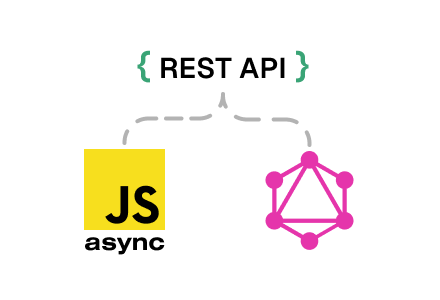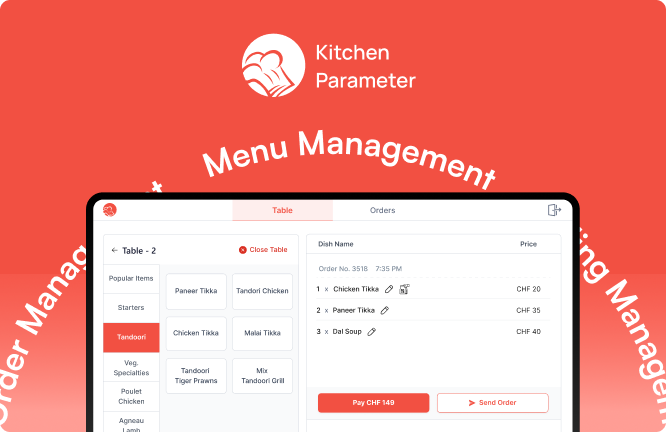Table of Contents
In the world of modern web and mobile applications, APIs play a crucial role in enabling seamless data exchange between different systems. One of the most widely used API architectures is the REST API (Representational State Transfer API). It provides a universal way for applications to exchange data on the internet using HTTP actions such as GET, POST, PUT, and DELETE.
REST APIs tend to be less efficient at times when dealing with large volumes of data or lots of requests.This is where Async JavaScript and GraphQL come into play. In this blog, we’ll explore how REST APIs work, why async JavaScript is essential for making efficient API calls, and how GraphQL can improve data fetching.
What is a REST API?
A REST API enables applications to talk to a server in terms of HTTP requests. It is based on a number of principles that enable it to be scalable, stateless, and simple to integrate with different front-end and back-end technologies.
Key Features of REST API:
1. Stateless Architecture
A REST API is stateless, meaning each request from a client to the server must contain all the information needed to process the request. The server does not store any client context between requests.
Why is Statelessness Important?
- Scalability: Since the server doesn’t maintain session data, it can handle multiple requests efficiently.
- Reliability: Each request is independent, reducing the risk of errors caused by previous interactions.
- Load Balancing: Stateless APIs work well with load balancers, allowing servers to distribute requests efficiently.
Example:
A client makes two separate API requests:
Request 1:
GET https://api.example.com/user/123
Response:
{
"id": 123,
"name": "John Doe",
"email": "john@example.com"
}
Request 2:
POST https://api.example.com/orders
Body:
{
"userId": 123,
"product": "Laptop",
"quantity": 1
}
- The second request does not rely on the first request’s data—it must include userId explicitly.
2. Uses HTTP Methods
REST APIs use standard HTTP methods for communication:
3. Resource-Based URLs
A REST API organizes its endpoints based on resources rather than actions.
Good API Design (Resource-Oriented):
- ✅ GET /users → Fetch all users
- ✅ GET /users/1 → Fetch a specific user
- ✅ POST /users → Create a new user
Bad API Design (Verb-Based):
- ❌ GET /getUser?id=1
- ❌ POST /createUser
- ❌ DELETE /removeUser?id=1
By following resource-based naming, REST APIs become more readable and predictable.
4. Supports JSON and XML Data Formats
REST APIs primarily use JSON for data exchange, but they also support XML and other formats.
Why JSON?
- Lightweight: Smaller size, faster transmission.
- Human-readable: Easier to understand and debug.
- Compatible with JavaScript: Works well with front-end applications.
Example of a JSON Response:
{
"id": 1,
"name": "Alice",
"email": "alice@example.com"
}
Some APIs also allow XML responses:
<user>
<id>1</id>
<name>Alice</name>
<email>alice@example.com</email>
</user>
5. Supports Caching for Performance Optimization
Caching helps reduce server load and speeds up responses by storing frequently accessed data.
Types of Caching in REST APIs:
- Client-side caching (Stored in browsers or apps)
- Server-side caching (Stored on API gateways or CDN servers)
Example Using Cache-Control Header:
GET /products HTTP/1.1
Host: api.example.com
Cache-Control: max-age=3600
- This tells the client to cache the response for one hour instead of making repeated API requests.
6. Layered System Architecture
A REST API follows a layered architecture, meaning different components handle different tasks, improving security and scalability.
Example of Layers in a REST API System:
- Client Layer: The front-end application (e.g., website, mobile app).
- API Gateway: Handles authentication, logging, and request routing.
- Application Layer: Processes business logic and interacts with databases.
- Database Layer: Stores and manages data.
Because of this structure, clients don’t need to know the backend implementation details—they just send requests to the API.
7. HATEOAS (Hypermedia as the Engine of Application State)
HATEOAS is an advanced REST API principle where responses contain links to related actions, making APIs more self-explanatory.
Example of HATEOAS Response:
{
"id": 101,
"name": "Laptop",
"price": 1200,
"links": [
{
"rel": "self",
"href": "/products/101"
},
{
"rel": "add-to-cart",
"href": "/cart/add/101"
}
]
}
- This API response guides the client on possible next actions (e.g., adding the product to the cart).
8. Security Features in REST API
Since REST APIs are widely used on the web, security is critical. Some key security mechanisms include:
Authentication & Authorization:
- OAuth 2.0 / JWT (JSON Web Token): Secure access with tokens.
- API Keys: Restrict access to authorized users.
Data Encryption:
- Use HTTPS (SSL/TLS) instead of HTTP to encrypt data.
Rate Limiting & Throttling:
- Limit API requests per user/IP to prevent abuse.
Example: Securing an API Request with a Token
GET /user/123 HTTP/1.1
Host: api.example.com
Authorization: Bearer YOUR_ACCESS_TOKEN
- This ensures only authenticated users can access the API.
Conclusion
REST APIs are powerful, flexible, and widely used in software development. Their stateless nature, use of HTTP methods, JSON support, caching, security features, and scalability make them the preferred choice for web and mobile applications.
By following best practices like resource-based naming, authentication, and HATEOAS, you can design REST APIs that are efficient, secure, and easy to maintain.
🚀 Need help developing a REST API for your business? Our team specializes in API development, integration, and optimization. Contact us today to discuss your project!
Using Async JavaScript for REST API Calls
JavaScript is single-threaded, meaning it executes one task at a time. When working with REST APIs, this can be inefficient because network requests take time, and JavaScript would normally wait for each request to complete before moving to the next task.
To solve this, JavaScript uses asynchronous programming, allowing API calls to run in the background while the rest of the code continues executing. This ensures a smooth user experience without freezing the application.
What is Async JavaScript?
Async JavaScript allows the program to continue running while waiting for API responses. This is achieved using:
- Callbacks (Older method)
- Promises (Improved approach)
- Async/Await (Best and modern approach)
Fetching REST API Data Using Async/Await
Let’s fetch user data from a REST API using JavaScript’s fetch() method and async/await.
async function fetchUserData(userId) {
try {
let response = await fetch(`https://api.example.com/users/${userId}`);
let data = await response.json();
console.log(data);
} catch (error) {
console.error("Error fetching user data:", error);
}
}
fetchUserData(1); // Fetch details of user with ID 1
Why Use Async/Await?
✅ Avoids callback hell
✅ Improves code readability
✅ Handles errors more effectively
By using await, JavaScript waits for the API response without blocking other tasks.
A Deep Dive into Using Async JavaScript for REST API Calls:
1. Understanding Synchronous vs. Asynchronous JavaScript
Synchronous Execution (Blocking Code)
In synchronous programming, tasks are executed one after another, and each task must complete before the next one starts.
Example of Synchronous Code
console.log("Start");
let data = fetch("https://api.example.com/users/1"); // This will block execution
console.log("End"); // This waits until the fetch call is complete
🚨 Problem: The fetch() call is slow because it waits for a response from the server. During this time, nothing else in the program can run.
Asynchronous Execution (Non-Blocking Code)
In asynchronous programming, JavaScript doesn’t wait for one task to complete before moving on to the next. Instead, it continues executing other tasks and handles the API response when it arrives.
Example of Asynchronous Code
console.log("Start");
fetch("https://api.example.com/users/1")
.then(response => response.json())
.then(data => console.log(data));
console.log("End");
✅ Benefit: The fetch() call runs in the background, allowing “End” to be logged before the API response arrives. This makes the app more responsive.
2. Making REST API Calls Using Async/Await
The async/await syntax makes asynchronous JavaScript code easier to read and write compared to .then() and .catch() callbacks.
Basic Syntax of Async/Await
- The async keyword makes a function asynchronous.
- The await keyword pauses execution inside an async function until the request completes.
Example: Fetching Data from a REST API Using Async/Await
async function fetchUserData(userId) {
try {
let response = await fetch(`https://api.example.com/users/${userId}`);
let data = await response.json();
console.log(data);
} catch (error) {
console.error("Error fetching user data:", error);
}
}
fetchUserData(1);
🔹 How It Works:
- fetch() makes a request to the API and waits for a response.
- await response.json() processes the response and converts it to JSON.
- try…catch handles errors gracefully.
✅ Advantages of Async/Await
✔ Easier to read and write
✔ Avoids nested callbacks (callback hell)
✔ Improves error handling with try…catch
3. Handling Multiple API Calls in Parallel
Sometimes, we need to fetch data from multiple endpoints at the same time. Instead of waiting for each request to complete one by one, we can run them in parallel using Promise.all().
Example: Fetching Multiple Users Simultaneously
async function fetchMultipleUsers() {
try {
let [user1, user2] = await Promise.all([
fetch("https://api.example.com/users/1").then(res => res.json()),
fetch("https://api.example.com/users/2").then(res => res.json())
]);
console.log(user1, user2);
} catch (error) {
console.error("Error fetching users:", error);
}
}
fetchMultipleUsers();
🔹 Why Use Promise.all()?
- Faster Execution: Runs both API calls simultaneously instead of one after the other.
- Better Performance: Reduces waiting time, making applications more efficient.
4. Handling API Errors in Async/Await
API calls can fail due to:
- Network issues (No internet, slow connection)
- Server errors (500 Internal Server Error)
- Invalid requests (404 Not Found)
To prevent app crashes, we must handle errors properly.
Example: Handling API Errors with Try…Catch
async function fetchUserData(userId) {
try {
let response = await fetch(`https://api.example.com/users/${userId}`);
if (!response.ok) {
throw new Error(`HTTP error! Status: ${response.status}`);
}
let data = await response.json();
console.log(data);
} catch (error) {
console.error("Error fetching user data:", error.message);
}
}
fetchUserData(9999); // If user 9999 does not exist, it will show an error
Key Error Handling Techniques:
- Check response.ok – If false, handle errors manually.
- Use try…catch – Catches network failures and prevents crashes.
- Log meaningful error messages – Helps in debugging.
5. Using Async/Await with POST Requests (Sending Data to REST API)
In addition to fetching data, we often need to send data to a REST API. This is done using POST requests with a request body.
Example: Creating a New User
async function createUser(newUser) {
try {
let response = await fetch("https://api.example.com/users", {
method: "POST",
headers: {
"Content-Type": "application/json"
},
body: JSON.stringify(newUser)
});
let data = await response.json();
console.log("User created:", data);
} catch (error) {
console.error("Error creating user:", error.message);
}
}
createUser({
name: "Alice",
email: "alice@example.com"
});
How It Works:
- We send a POST request to /users with JSON.stringify(newUser).
- The server processes the request and returns the new user’s details.
6. Using Async/Await in Real-World Applications
Where is Async/Await Used?
✅ Fetching dynamic data in React, Angular, Vue.js applications
✅ Loading external content (news, social media feeds, APIs)
✅ Handling user authentication (Login, Logout, Token Refresh)
✅ Integrating payment gateways (Stripe, PayPal API)
Example: Fetching Weather Data for a City
async function fetchWeather(city) {
try {
let response = await fetch(`https://api.weatherapi.com/v1/current.json?key=YOUR_API_KEY&q=${city}`);
let weatherData = await response.json();
console.log(`${city} Weather:`, weatherData.current.temp_c + "°C");
} catch (error) {
console.error("Error fetching weather:", error.message);
}
}
fetchWeather("New York");
Practical Use Case: This technique is used in weather apps, travel websites, and real-time dashboards.
Conclusion:
Using Async JavaScript with REST APIs significantly improves performance and user experience. By leveraging async/await, developers can:
✔ Fetch API data without blocking the UI
✔ Handle multiple requests in parallel
✔ Improve error handling and debugging
✔ Send data efficiently with POST requests
🔹 Looking for API development services? Our team specializes in REST API integrations, JavaScript development, and backend solutions. Check out our Staff Augmentation services to scale your development team or contact us today to discuss your project!
Challenges with REST API and How GraphQL Helps
Although REST APIs are widely used, they have some limitations:
- Over-fetching: Retrieving more data than needed.
- Under-fetching: Making multiple requests to gather required data.
- Multiple Endpoints: Each resource has a separate endpoint.
What is GraphQL?
GraphQL is a query language that allows clients to request only the data they need from an API, reducing unnecessary network requests.
Unlike REST, where you request predefined responses, GraphQL gives you flexibility to specify exactly what you want.
GraphQL vs. REST API: Key Differences
Accessing a REST API Through GraphQL
If you already have a REST API, you can wrap it inside a GraphQL server to get the benefits of flexible data fetching.
Setting Up GraphQL to Fetch REST API Data
Let’s create a GraphQL API that fetches user data from an existing REST API.
Step 1: Install Dependencies
npm install express graphql apollo-server-express node-fetch
Step 2: Create a GraphQL Server
const express = require('express');
const { ApolloServer, gql } = require('apollo-server-express');
const fetch = require('node-fetch');
const typeDefs = gql`
type User {
id: ID
name: String
email: String
}
type Query {
getUser(id: ID!): User
}
`;
const resolvers = {
Query: {
getUser: async (_, { id }) => {
const response = await fetch(`https://api.example.com/users/${id}`);
return response.json();
}
}
};
async function startServer() {
const app = express();
const server = new ApolloServer({ typeDefs, resolvers });
await server.start();
server.applyMiddleware({ app });
app.listen(4000, () => console.log('Server running on http://localhost:4000/graphql'));
}
startServer();
Step 3: Querying the API Using GraphQL
After starting the server, open GraphQL Playground (http://localhost:4000/graphql) and run this query:
query {
getUser(id: "1") {
name
email
}
}
Instead of fetching unnecessary data, GraphQL gives you exactly what you request!
Combining REST API, Async JavaScript, and GraphQL
By integrating REST API, Async JavaScript, and GraphQL, developers can build more efficient and flexible applications. Here’s how:
- Use REST API for standardized data communication.
- Use Async JavaScript (async/await) to handle API requests efficiently.
- Use GraphQL to minimize data over-fetching and improve API performance.
Combining REST API, Async JavaScript, and GraphQL in Real-World Applications
Many modern applications use a hybrid approach:
- Use REST APIs for simple, resource-based interactions.
- Use Async JavaScript (fetch + async/await) for efficient API calls.
- Use GraphQL as a flexible query layer over REST APIs.
Example: A React App Fetching Data from REST API and GraphQL
async function fetchUserData() {
const restResponse = await fetch("https://api.example.com/users/1");
const restData = await restResponse.json();
const graphQLQuery = `
query {
getUser(id: 1) {
name
email
}
}
`;
const graphQLResponse = await fetch("https://graphql-api.example.com", {
method: "POST",
headers: { "Content-Type": "application/json" },
body: JSON.stringify({ query: graphQLQuery })
});
const graphQLData = await graphQLResponse.json();
console.log("REST API Data:", restData);
console.log("GraphQL Data:", graphQLData.data.getUser);
}
fetchUserData();
Conclusion
REST APIs are a powerful way to enable communication between applications, but they can sometimes lead to performance issues. By leveraging Async JavaScript, we can make non-blocking API calls, improving application responsiveness. Furthermore, GraphQL provides a more efficient way to fetch data, reducing unnecessary API requests.
At Kryptoninc, we specialize in API development, integration, and software solutions to help businesses optimize their digital infrastructure. Whether you need a high-performance REST API or want to transition to GraphQL, our team is here to assist you.
👉 Looking for API development services? Contact us today to discuss your project!
FAQs: REST API, Async JavaScript, and GraphQL
REST API (Representational State Transfer) is an architectural style that allows applications to communicate over HTTP using standard methods like GET, POST, PUT, and DELETE.
Async JavaScript, using Promises and async/await, allows non-blocking operations, improving API response times and overall application performance.
Unlike REST, GraphQL allows clients to request only the needed data, reducing over-fetching and under-fetching, leading to more efficient API calls.
Use REST for standard CRUD operations and simpler APIs, while GraphQL is better for complex queries and scenarios requiring optimized data fetching.
Async JavaScript enables concurrent API requests, reducing delays and enhancing the user experience by preventing blocking operations.
GraphQL provides flexible queries, reduces multiple API requests, improves efficiency, and minimizes data transfer for better performance.
Yes! Many systems use a hybrid approach where REST handles simpler endpoints while GraphQL manages complex queries efficiently.
Use techniques like request batching, caching, error handling, and optimizing API endpoints to reduce latency and improve efficiency.
We provide expert API development, optimization, integration, and consulting services to ensure seamless and efficient API performance.
Slow REST API performance can result from poor optimization, inefficient queries, or lack of caching. Our API development services ensure faster, more efficient API performance. Learn more here.


